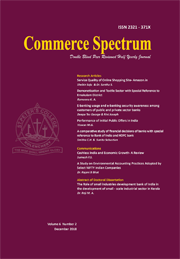Bank Credit Utilisation by Agriculturists and MSMEs: An Empirical Study With Reference To Kerala
Author(s) : Dr. Suby BabyVolume & Issue : VOLUME 1 / 2013 , ISSUE 1
Page(s) : 7
Abstract
The paper examines the utilisation of bank credit by micro, small and medium enterprises (MSMEs) in the selected districts of Kerala. One of the cardinal principles behind sanctioning a loan is to use it for the purpose for which it was granted. However, diversions of credit for unspecified purposes are alleged to be diluting the objective of lending. Moreover, most of the bank officials are pressured by target oriented lending and to fulfil their target, most of the time, they relax the lending and utilisation norms. Eventually, it results in loan default and utilization gap. The empirical results show that a large majority of the borrowers (63.8%) utilized credit for the purpose for which it was sanctioned and the rest (36.2%) diverted the credit. Again, 38.2 per cent of the borrowers diverted 10 to 20 per cent of their loan amount and 33.6 per cent diverted 30 to 40 per cent. Further, 53.9 per cent of the borrowers, who diverted the loan, used the amount for unproductive purposes and none more than 7.4 per cent used it for productive purposes. This paper insinuates banks to cautiously design an efficient and effective mechanism to identify an eligible borrower and the point at which the borrower diverts the loan. Ensuring proper scrutinizing of the borrowers along with adequate credit flow and efficient monitoring machinery will definitely alleviate the chances of default, which rescue the borrower from the claws of insolvency and the bank from the snatch of over dues syndrome.
Keywords
Bank Credit Utilization, Credit Diversion, Credit Utilisation Gap, MSME Credit Utilisation, Credit Overdue
References
Basu, P (2006). “Improving access to Finance for India’s Rural Poor”, Washington D.C: The World Bank.
Chaudhry Kamran Naseer (2010). “Agriculturecredit is critical for the flood-hit farmers’ subsistence”, Business and Finance Review, Vol.5 (2), January.
Government of Kerala (2009).Economic Review,State Planning Board, Thiruvananthapuram.
Hans,V.Basil (2006). “Towards A Vibrant Indian Culture”, Kissan World, Vol 33(2), February, pp. 18-20.
James Manalel (1994). “Role of incentives in the development of small scale industrial units in Kerala”, Ph.D Thesis, Cochin University, Cochin.
Prasad, C.S (2006). “Micro, Small and Medium enterprises financing in India: Issues and concerns”, Cab Calling, July-Sept 2006, pp 35-40.
Press Trust of India (2009). “20-PSU banks fail to meet farm sector lending target till November”, The Economic Times. Retrieved from http://economictimes.indiatimes.com.
Rahji, M.A.Y and S. B. Fakyode (2009). “A multinomial logit analysis of agricultural credit rationing by commercial banks in Nigeria”, International Research Journal of Finance and Economics, Issue .24, Nigeria.
Singh, S. K and Singh, S (2009). “Use of institutional credit for sustainable agriculture production” GCRA, International Conference on communication for development in the information age: Extending benefits of technology for all, Banaras Hindu University, Varanasi.
.png)

